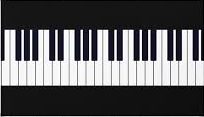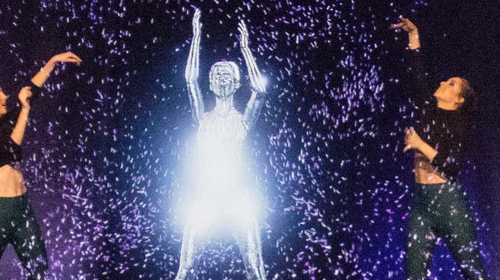Nick Krewen
Music, Wed. June 14, 2017
You may not have heard of Maya Kodes, but over the past year, the slender blond singer has released a dance pop song on iTunes, recorded an EP set for release in June, performed 30 concerts and amassed 5,500 Facebook followers.
Pretty impressive for a hologram.
Billed as the world’s first interactive real-time virtual pop star, Kodes is the creation of Montréal’s Neweb Labs.
In development for 18 months, she’s the brainchild of Yves St-Gelais, producer of the popular Radio-Canada TV series ICI Laflaque, and a former Cirque du Soleil comedian and director.
Kodes has already been road-tested at the company’s custom-designed holographic Prince Theatre, where she performed a fluffy dance-pop confection called “Boomerang” — the song currently for sale on iTunes — amid a flesh and blood dance crew and in front of a largely tween audience, kibitzing with the show’s emcee in a fromage-filled routine that bordered on juvenile.
It’s also the venue from where Kodes will present, on June 13, a 360-degree livestream VIP performance to launch her first EP, The New Kode Vol. 1.

A Toronto performance is expected before the end of the year, says Neweb spokesperson Élodie Lorrain-Martin.
“We really want to do a world tour and also have her perform in multiple venues at the same time,” says Lorrain-Martin.
Since holograms have already performed — late rapper Tupac Shakur was resurrected at Coachella in 2012 as was the late Michael Jackson at the 2014 Billboard Music Awards — Neweb’s ambition is plausible.
Onstage, Kodes is a chameleon of special effects, changing costumes and skin pigmentation in the blink of an eye; shooting sparkles from her hands and instantly cloning herself into a Maya army.
But what makes Kodes stand apart from Shakur, Jackson and the 3D Japanese anime star Hatsune Miku — who has already toured Japan and North America as a singing hologram — is that she isn’t strictly a playback apparition.
“Every other holographic project on the market right now is all playback,” Lorrain-Martin says. “She’s the first one in the world to be able to interact in real time.”
How Kodes manages to do this involves a bit of smoke-and-mirrors: the onstage Maya is embodied by two people hidden from view.
The first, Erika Prevost, best known as Sloane on the Family Channel’s The Next Step, portrays the physical Maya, her choreographed movements relayed by motion capture cameras and a bank of five computers as she cavorts with onstage dancers. Prevost also provides Kodes’ speaking voice, keeping an eye on her audience through an onstage camera, which lets her gauge the crowd’s response and even indulge in a Q&A if desired.
Then there’s a woman who provides Kodes’ singing voice, whom Lorrain-Martin refuses to identify.
Kodes’ virtual existence even has a back story.
“She was created from the Y2K bug,” says Lorrain-Martin. “The reason the Y2K bug never happened was because Maya was created to solve it. Then she evolved into this code that was flying through Facebook and Skype and the Internet in general and, through a glitch, she happened to be created. The first thing she heard in the adult world was music, so that’s what she wanted to do: music. That’s the story.”
The story doesn’t explain how a collage of digital ones and zeros could possibly listen to music, but it’s obvious that Neweb has gone to great lengths to make Maya “authentic” to herself. They’ve hired songwriters to write tunes about the everyday problems that Kodes faces (i.e. rebooting) and acknowledge that she can’t truly love because she’s a hologram who disappears into her own world when powered down.
While it’s obvious that Neweb has gone to great expense to launch Kodes, Lorrain-Martin won’t divulge any numbers aside from the amount the company received from the Canada Media Fund: $1.3 million.
“It’s a big project and very ambitious,” Lorrain-Martin concedes, “We believe that this new concept and the technology is going to pay us back because it’s something that’s received a lot of interest from people in the industry. There are a lot of uses . . . for other projects.”
The event management sector is particularly interested in Neweb’s results, Lorrain-Martin says, and admits another character is under development: a male comedian and singer that will probably be launched in the next six months.
But is Maya Kodes considered a true hologram? Not according to Emmy-winning technical director Laurent Abecassis, who won his award supervising plane crash sequences on the groundbreaking TV series Lost.
He’s also one of the core 12 team members who helped bring Maya to life.
“Holograms do not really exist,” explains Abecassis, defining a hologram as “something that could pop into the middle of your living room, from any angle, without any screens.”
“We create the illusion that they exist,” he says. “We use a system that allows us to create the illusion of presence. That you can have eye contact with the character and the character can reply and talk to you: that’s really the breakthrough here.”
Abecassis says combining motion capture with holographic technology is a recent development.
“The reason it hasn’t been done before was because it wasn’t possible from the computing standpoint,” he explains. “Computers didn’t have enough power to do that.”
The next step, he says, is to incorporate a holographic image in a duet setting, “like Maya taking the stage with a celebrity.”
At the moment, Maya is still a solo artist. Lorrain-Martin says that by October Neweb will offer a 60-minute Kodes concert.
And as Kodes’ career grows, Maya will get a life.
“We’re going to explore more. Maybe she’s going to have a pet. Maybe she’s going to have a boyfriend. That’s going to come later,” says Lorrain-Martin.


Be the first to comment on "Maya Kodes is a new kind of virtual pop star"